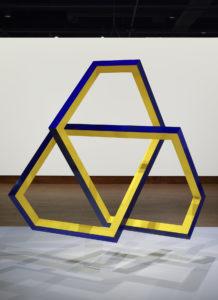Coming to New York City from San Francisco in 1961, Myers entered a rapidly changing art scene. American artists were ripping away established European traditions, replacing them with Abstract Expressionism, Pop, Minimalism, Conceptualism, Earth Art, Hard Edge painting and sculpture, and embracing Art and Technology. The cultural changes of the social justice movements and the anti-war protests were intertwined with the daily lives of Frosty and other artists. Their camaraderie at the famed New York City bar Max’s Kansas City created synergies in art, music and culture.
These artists pioneered living and working in abandoned lofts and led the urban renewal in what became the downtown scene in lower Manhattan, Soho and ultimately Brooklyn. Frosty’s wide-ranging works include NYC landmark artwork “The Wall” aka the Gateway to SoHo, “The Moon Museum,” which was the first art placed on the Moon, and his radical furniture that blurred the lines of art and design.
Visit the first floor Special Exhibition galleries to see Frosty Myers’ 1966 sculpture Lazers Daze (Zane’s Match), currently on view as part of Moving Vision.
Lazers Daze (Zane’s Match), 1966
Aluminum and acrylic lacquer
This sculpture is made of one continuous line, which turns and overlaps itself to form a shape known as a cubic trefoil. The work is painted in yellow and blue, and as it rotates, the dominant color seems to change. From one angle, the work appears to have a yellow outline and blue interior, but from the opposite angle, the colors seem to reverse.
Forrest Myers, known as Frosty, was a co-founder of the Park Place Gallery in SoHo, in New York City, in the early 1960s. He and others in the group were looking for new means of expression and new mediums for their art. Myers became obsessed with lasers, a recent scientific invention that was not readily available to the public. He began designing works of art that would incorporate lasers in 1963, but he was not able to realize them until 1967. Lazers Daze takes its title from his interest in this cutting-edge new technology.
Collection of Beau R. Ott











